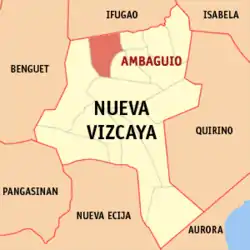Ambaguio
Ambaguio, officially the Municipality of Ambaguio (Ilocano: Ili ti Ambaguio; Tagalog: Bayan ng Ambaguio), is a 5th class municipality in the province of Nueva Vizcaya, Philippines. According to the 2015 census, it has a population of 15,250 people. [3]
Ambaguio | |
|---|---|
| Municipality of Ambaguio | |
 Seal | |
 Map of Nueva Vizcaya with Ambaguio highlighted | |
OpenStreetMap 
| |
.svg.png.webp) Ambaguio Location within the Philippines | |
| Coordinates: 16°31′54″N 121°01′41″E | |
| Country | |
| Region | Cagayan Valley (Region II) |
| Province | Nueva Vizcaya |
| District | Lone district |
| Barangays | 8 (see Barangays) |
| Government | |
| • Type | Sangguniang Bayan |
| • Mayor | Arnold P. Dinungon |
| • Vice Mayor | Nardo C. Agnahe |
| • Representative | Luisa L. Cuaresma |
| • Electorate | 6,800 voters (2019) |
| Area | |
| • Total | 156.26 km2 (60.33 sq mi) |
| Elevation | 952 m (3,123 ft) |
| Population | |
| • Total | 15,250 |
| • Density | 98/km2 (250/sq mi) |
| • Households | 3,535 |
| Economy | |
| • Income class | 5th municipal income class |
| • Poverty incidence | 23.9% (2015)[4] |
| • Revenue | ₱62,739,235.03 (2016) |
| Time zone | UTC+8 (PST) |
| ZIP code | 3701 |
| PSGC | |
| IDD : area code | +63 (0)78 |
| Climate type | tropical rainforest climate |
| Native languages | Ilocano Kallahan language Tagalog |
Etymology
The name "ambaguio" was from the word "bagiw," meaning "moss" which covered every inch of trees and stones in the area. The inhabitants were called "e-am-bagiw" meaning "conqueror of moss."
The name underwent a series of changes due to its difficult pronunciation by the lowland people who later settled in the area, resulting in the present "Ambaguio."
History
A handful of settlers headed by Fausto Tagangtang who came from the neighboring Mountain Province pioneered and disturbed the tranquility of the place transforming the wilderness into growing prosperous farm hills and rice terraces.
Due to its terrain, distance and road problems, the inhabitants composed only of three major tribes: Igorot, Ifugao, and Ibaloi, who came to the place for refuge for a better living, shelter and justice and were united under the leadership of Fausto Tagangtang. The inhabitants, by way of a unanimous decision, called the place “Ambaguio”, which means “the land of mosses”, and “its climate is similar to that of Baguio”.
Before its creation as a municipality, Ambaguio was then a barrio of the Municipality of Bayombong. Hon. Leonardo B. Perez, then Congressman of Nueva Vizcaya, authored the bill seeking for the creation of Ambaguio as an independent municipality. The bill was approved on 18 June 1966 by virtue of Republic Act. No. 4735.[5] In the same year, Mr. Mariano L. Agnahe, the then Incumbent Barrio Lieutenant, was appointed as the first mayor of the town.
Barangays
Ambaguio is politically subdivided into 8 barangays.
- Ammoweg
- Camandag
- Labang
- Napo
- Poblacion
- Salingsingan
- Tiblac
- Dulli
Demographics
| Year | Pop. | ±% p.a. |
|---|---|---|
| 1970 | 1,416 | — |
| 1975 | 3,000 | +16.25% |
| 1980 | 3,856 | +5.15% |
| 1990 | 7,241 | +6.51% |
| 1995 | 9,485 | +5.19% |
| 2000 | 9,750 | +0.59% |
| 2007 | 11,499 | +2.30% |
| 2010 | 13,452 | +5.87% |
| 2015 | 15,250 | +2.42% |
| Source: Philippine Statistics Authority [3] [6] [7][8] | ||
References
- Municipality of Ambaguio | (DILG)
- "Province: Nueva Vizcaya". PSGC Interactive. Quezon City, Philippines: Philippine Statistics Authority. Retrieved 12 November 2016.
- Census of Population (2015). "Region II (Cagayan Valley)". Total Population by Province, City, Municipality and Barangay. PSA. Retrieved 20 June 2016.
- "PSA releases the 2015 Municipal and City Level Poverty Estimates". Quezon City, Philippines. Retrieved 1 January 2020.
- "An Act Creating the Municipal District of Ambaguio in the Province of Nueva Vizcaya". LawPhil.net. Retrieved 2021-01-12.
- Census of Population and Housing (2010). "Region II (Cagayan Valley)". Total Population by Province, City, Municipality and Barangay. NSO. Retrieved 29 June 2016.
- Censuses of Population (1903–2007). "Region II (Cagayan Valley)". Table 1. Population Enumerated in Various Censuses by Province/Highly Urbanized City: 1903 to 2007. NSO.
- "Province of Nueva Vizcaya". Municipality Population Data. Local Water Utilities Administration Research Division. Retrieved 17 December 2016.
External links
- Ambaguio Profile at PhilAtlas.com
- Philippine Standard Geographic Code
- Philippine Census Information
- Local Governance Performance Management System